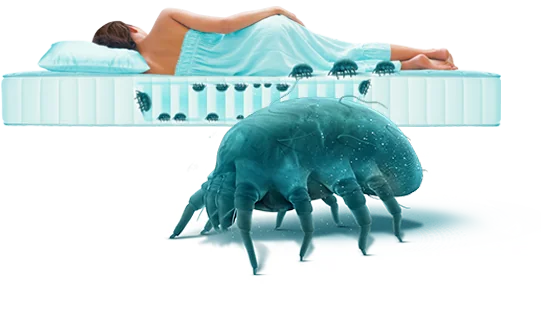
Impacts and consequences of dust mite allergy

A sneeze or two and some light congestion are not the only impacts of dust mite allergy. If you’re sensitive to dust mite allergens, keeping your face and body in close contact with mites and their droppings for 7 to 8 hours every night can have impacts not just on your physical health, but on your mental health – or those of your child.
Primary symptoms: congestion, sneezing and irritation
Waking up in the morning with itchy eyes and a streaming nose is no fun. But, imagine waking up like this day after day or even year after year.
The direct symptoms caused by an exaggerated immune response to dust mite allergens include:
- allergic rhinitis (stuffy, runny nose)
- sneezing
- red, itchy eyes (conjunctivitis)
- asthma (wheezing, breathing trouble)
- red, flaky skin rash (atopic dermatitis) Suffering from one or more of these symptoms in the long run can reduce your well-being or that of your dust mite-sensitive child, leading to more concerning secondary symptoms.

Did you know?
Pets can also be allergic to dust mites. Common symptoms are itchy skin, rashes and recurring ear infections.
Secondary symptoms: sleep and mood disorders
After spending a significant period plagued by dust mite allergy, sleep quality may decrease. More than 3 in 4 allergy sufferers complain of sleep problems, which often leads to a host of additional physical and psychological challenges:
- chronic fatigue and daytime drowsiness
- trouble concentrating at work or school
- lower occupational or academic performance, absenteeism
- impacts on social relationships
- mood disorders
- unhealthy appearance (dark circles under eyes, redness, swelling)
- fear of playing sports
Research has shown that productivity loss caused by allergy symptoms (around 20%!) has significant health and socioeconomic impacts, particularly with the rising instance of allergy; up to 30% of the adult population suffers from allergic rhinitis.
Driving performance in people suffering from allergies is significantly impaired, as are cognitive functions when performing long tasks.
The impacts of allergy symptoms like rhinitis and rhinoconjunctivitis in adolescents may be different than those in adults, and have far-reaching effects on academic achievement and daily activities.

Did you know?
Allergic rhinitis is medically associated with poorer exam performance in teenagers, becoming even worse when they are taking sedating antihistamines for their symptoms on exam day.
The long-term effects of ignoring treatment
Failing to treat dust mite allergy does not desensitise sufferers – it does the opposite. Your allergy may evolve into a severe form with greater impacts on your daily life, and which may become more difficult to treat. There is also a risk that your untreated allergic rhinitis will develop into asthma. This is why it is important to diagnose and treat allergic rhinitis as rapidly as possible.
Furthermore, continuous asthma symptoms can ultimately damage your lungs. Even if you aren’t actively experiencing an attack, if you are asthmatic due to dust mite allergy, your airways may still be inflamed. A well-developed asthma management plan keeps symptoms under constant control to prevent permanent airway injury; it’s not enough to simply deal with attacks when they happen.
Why suffer at all?
Even if your dust mite allergy symptoms aren’t debilitating, why continue to suffer their annoying effects when you can take steps to reduce – and even eliminate – the presence of dust mites in your home ? Your respiratory system and long-term health will thank you!
Looking for ways to make your home less inviting for dust mites? Discover them in our blog post.

Benjamin Tillier
Benjamin Tillier has more than 18 years of international experience in various sectors. He has been active in the healthcare industry since 2011. In regular contact with dust mites allergic people as well as professors and allergy specialists, he acquired an in-depth knowledge in this field.
Related articles



